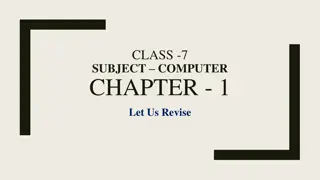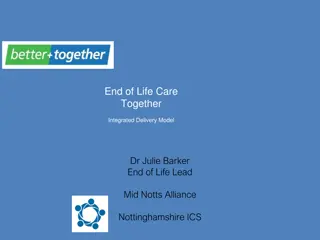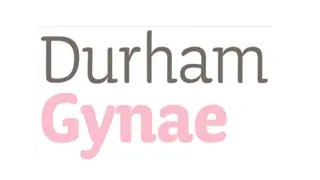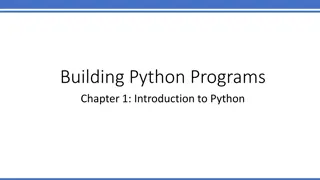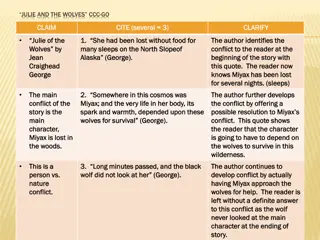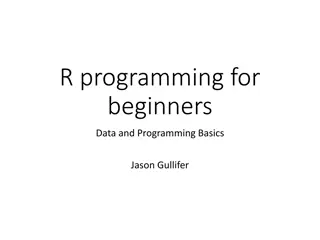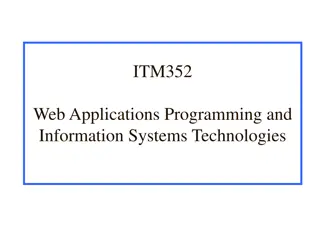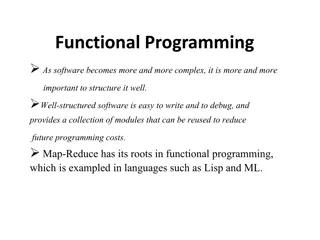Programming in C++ for Beginners with Professor Julie Harazduk
Dive into the world of programming with a course taught by Professor Julie Harazduk at Fordham University. Learn fundamental programming concepts and key techniques using the C++ language. Attend lectures, complete lab assignments, and engage in quizzes and exams to solidify your skills. Enhance your understanding by studying the interactive textbook and following the guidance provided for success in the class.
Download Presentation

Please find below an Image/Link to download the presentation.
The content on the website is provided AS IS for your information and personal use only. It may not be sold, licensed, or shared on other websites without obtaining consent from the author.If you encounter any issues during the download, it is possible that the publisher has removed the file from their server.
You are allowed to download the files provided on this website for personal or commercial use, subject to the condition that they are used lawfully. All files are the property of their respective owners.
The content on the website is provided AS IS for your information and personal use only. It may not be sold, licensed, or shared on other websites without obtaining consent from the author.
E N D
Presentation Transcript
CISC 1600/1610 Computer Science I Programming in C++ Professor Julie Harazduk jharazduk@fordham.edu Office: JMH 338
Each class Take Attendance on BB Click the Class Click Tools Click Qwikly Attendance Enter the 4 digit number
This is a course In Programming For beginners who want to become professionals i.e., people who produce systems that others will use who are assumed to be bright Though not (necessarily) geniuses who are willing to work hard Though do need sleep occasionally, and take a normal course load Using the C++ programming language 3
Instructor Prof. Julie Harazduk Email: jharazduk@fordham.edu Office hours: Tue/Fri 1:00-2:15, Thu 11:30-12:30 Using Zoom: https://fordham.zoom.us/j/2382029517 Office: JMH 338, but only by appointment. Website:https://storm.cis.fordham.edu/harazduk/cs1600 4
Introduction to programming with C++ Learn Fundamental programming concepts Key techniques Basic C++ facilities By the end of the course, you will be able to: Write small C++ programs Read much larger programs Learn the basics of many other languages Proceed to advanced C++ courses 5
Requirements Attendance and participation Lectures and lab sessions Lab assignments roughly 12 across semester Quizzes each 15 minutes, 2 across semester Exams 1 midterm, 1 final Academic integrity may discuss assignments with your classmates, but you MUST write all your code and all your answers yourself 6
How to succeed in class Ask questions In class In office hours JMH 338, tutor room JMH 310 Study together and discuss assignments with each other (without plagiarizing!) Read Textbook Read and re-read the material, self-test! Complete practice problems for credit! Start coding and studying early PLAY Around! 7
Course textbook We will be using an interactive book, called a zyBook. This is how you get it: 1. Sign in or create an account at learn.zybooks.com 2. Enter zyBook code: FORDHAMCISC1600HarazdukFall2021 3. Hit Subscribe 8
Course Material http://storm.cis.fordham.edu/harazduk/cs1600 Go online for Announcements Lecture slides Course materials/handouts Assignments 9
Two courses in one: CISC 1600 and CISC 1610 CISC 1600 and 1610 cover lecture and lab We may work in lab during lecture time We may have lecture during lab time Listen for announcements during class/online! 10
A program provides a computer with a set of simple instructions to achieve a goal 11
Think about a program to put on a jacket? What does it need to do? How exact does it need to be? We ll come back to it.
Programs are everywhere On your computer: Web browser Request and display information from distant sites Word processor Record text, change appearance, save to disk Anywhere else? 13
Programs are everywhere In the dining hall: Cashier Compute price of food purchase, charge payment to account, (if pay cash: compute change) HVAC Monitor temperature, adjust A/C or heating And beyond Self-Driving Car! 14
Programs have to be precise Programs are written in a programming language. Programs must use correct grammar (syntax). Programs must have correct logic (semantics). Programs run on a computer. Most computers are dumb. They do exactly what you say to do, not what you meant for them to do. They can t fill in missing details. If you leave out a detail, it won t get done. 16
Computer system structure Central processing unit (CPU) performs all the instructions Output Memory stores data and instructions for CPU CPU Input collects information from the world Output provides information to the world Input 17
Tiny Bit of C++ History Built as an extension of C C (Kernigan & Ritchie Bell Labs 1969-1972) By Bjarne Stroustrup at Bell Labs (Danish Masters in Math & CS) Began in 1979. First published in 1985 18
Why C++? Popular modern programming language In use since 1980 s Similar structure to many/most other popular languages (Java, C#, Javascript) Exposes low level concepts in a high level language. Take CISC2000/2010 to see the low level and high level constructs. 19
Ready program to put on a jacket? What does it need to do? How exact does it need to be? How would you start?
Pseudocode to put on a jacket Pick up jacket with two hands Repeat the following until the jacket is upright Turn jacket in x,y dimension 90 degrees Are sleeve openings facing you? Turn jacket in x,z dimension 180 degrees Pick one hand to hold jacket Place other hand into opposing sleeve and push arm thru 21
Programming Process Start with a goal Chocolate chip cookies! Mmmm Break it down into steps 22
Chocolate Chip Cookies Ingredients (makes 4 dozen) What are the 4 general steps? Step 1: 1 cup butter, softened 1 cup white sugar 1 cup packed brown sugar 2 eggs 2 teaspoons vanilla extract 1 teaspoon baking soda 2 teaspoons hot water teaspoon salt 3 cups all-purpose flour 2 cups semisweet chocolate chips 1 cup chopped walnuts Step 2: Step 3: Step 4: 23
4 Dozen Chocolate Chip Cookies Ingredients (makes 4 dozen) Step 1: Preheat oven to 350 degrees F Step 2: Mix Everything 1 cup butter, softened 1 cup white sugar 1 cup packed brown sugar 2 eggs 2 teaspoons vanilla extract 1 teaspoon baking soda 2 teaspoons hot water teaspoon salt 3 cups all-purpose flour 2 cups semisweet chocolate chips 1 cup chopped walnuts Step 3: Drop large spoonfuls onto pans Step 4: Bake 24
How do we 'talk to a computer'? Programming 'Languages' Like spoken languages: you must practice there are several ways to say the same thing Unlike spoken languages: The 'answers' are deterministic (predictable) The grammar is super picky, such as Where you put punctuation, capitalization 25
C++ high-level language High-level language Uses words to describe instructions More intuitive to people Computer-independent Machine-language Uses binary to describe instructions Less intuitive to people Computer-dependent C++ code balance=balance-charge; Compiler assembly code 10000000 10000100 00110010 01110100 machine code 26
Compiler C++ code Converts your code (Sometimes first to Assembly or byte-code, sometimes directly to machine code) balance=balance-charge; Assembly code to Machine code Machine code 0000 0010 0010 1011 1000 1000 0010 0010 27
Binary Machine code (binary) is made only of 0s and 1s? 0000 0010 0010 1011 1000 1000 0010 0010 Why? 1 Binary Digit is a Bit 8 Binary Digits is a Byte 28
A Little Bit about Binary How high can you count on one hand? Technique: Finger up is 1 Finger down is 0 4 2 8 16 1 Add the values showing Answer: Binary 11111 = 31 Now count up from 0! 29
#1. Convert this binary value to decimal Place value 16 8 4 2 1 0 0 1 1 02 30
#1. Convert this binary value to decimal Place value 16 8 4 2 1 = 610 0 0 1 1 02 31
#2. Convert this binary value to decimal Place value 16 8 4 2 1 1 1 0 1 02 32
#2. Convert this binary value to decimal Place value 16 8 4 2 1 = 2610 1 1 0 1 02 33
Convert Decimal (base 10) to Binary (base 2) 16 8 4 2 1 22 ? ? ? ? ? Sum: + + + + + Similar to making change How do you hand someone 68 cents? Anyone? Answer: Pick from high value coins to low 2 Quarters, (subtract 50, leaving 18 cents) 1 dime, leaving 8 cents 1 nickel, leaving 3 cents, then 3 pennies. 34
Give the Binary Value for: 510 16 8 4 2 1 0 0 1 0 1 Sum: Sum: +0 + +0 + +4 + +0 + +1 + 35
Give the Binary Value for: 1210 16 8 4 2 1 0 1 1 0 0 Sum: Sum: +0 + +8 + +4 + +0 + +0 + 36
Give the Binary Value for: 2610 16 8 4 2 1 1 1 0 1 0 Sum: Sum: +16 + +8 + +0 + +2 + +0 + 37
Convert Decimal (base 10) to Binary (base 2) 16 8 4 2 1 22 1 0 1 1 0 Generate 2210 in binary 16? Yes. (1). 22-16 = 6. 8? No. (0). 4? Yes. (1) 6-4 = 2. 2? Yes. (1) 2-2 = 0. 1? No. (0) 38
Course outline Programming basics, input/output, arithmetic Conditional statements Loops Modularity functions Complex data arrays, strings, and classes Throughout the semester: Proper programming style 40
American Standard Code for Information Interchange Each character is stored in 1 byte (ASCII binary)
Programming basics Input Information Perform Calculations Output Information Let's start here 43
What is the name of every first program? Every course in every programming language starts here!
Our first program: Hello world! Create filename hello.cpp to include: // include library of standard input and output commands #include <iostream> using namespace std; Standard int main() { // Begin main function cout << "Hello world!\n"; // output "Hello world! return 0; /* indicate successful program completion */ } // End main function > g++ hello.cpp > ./a.out Hello world! > 45
The components of Hello world! Comments //, /* */ main function Preprocessor directives #include Literally includes the contents of the file named between <> during the compilation process [Compilation goes thru 4 steps: preprocess, compile, assemble, link]. 46
Using comments // include library of standard input and output commands #include <iostream> using namespace std; int main() { // Begin main function cout << "Hello world!\n"; // output "Hello world!" return 0; /* indicate successful program completion */ } // End main function Explain programs to other programmers Ignored by compiler Syntax: // single line comment /* multi-line comment */ 47
Preprocessor directives // include library of standard input and output commands #include <iostream> using namespace std; int main() { // Begin main function cout << "Hello world!\n"; // output "Hello world!" return 0; /* indicate successful program completion */ } // End main function Lines beginning with # Executed before compiling the program 48
main function // include library of standard input and output commands #include <iostream> using namespace std; int main() { // Begin main function cout << "Hello world!\n"; // output "Hello world!" return 0; /* indicate successful program completion */ } // End main function Every C++ program has the function int main() main contains the instructions to be executed by the program The instructions included in the body of main are placed between curly braces { } 49
Statements // include library of standard input and output commands #include <iostream> using namespace std; Note that the body of main is indented. Always indent between brackets! int main() { // Begin main function cout << "Hello world!\n"; // output "Hello world!" return 0; /* indicate successful program completion */ } // End main function Instructions to be performed when the program is run Each statement is completed with a ; 50
Organize Using white spaces // include library of standard input and output commands #include <iostream> using namespace std; int main() { // Begin main function cout << "Hello world!\n"; // output "Hello world!" return 0; /* indicate successful program completion */ } // End main function White spaces are blank lines, space characters, and tabs White spaces are ignored by the compiler Use indentation to group pieces of code together 51
DIRECTORY STRUCTURE WRITING AND COMPILING PROGRAMS WITH LINUX





